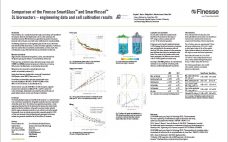Antibody-mediated haemolysis is a hard-to-predict phenomenon with potentially severe consequences. It is mediated by naturally-occurring anti-A and anti-B immunoglobulin isoagglutinins, which are present in plasma, blood, and several derived products, including IVIG produced by plasma fractionation. Prometic Bioseparations have developed an affinity chromatography resin for the removal of isoagglutinins from plasma and plasma derived products, such as IVIG. The resins, IsoClear A and IsoClear B, can clear isoagglutinins from a titre of 1/32 down to negative agglutination using a load…
Year of Publication
Expansion, Recovery and Characterization of hMSCs on Dissolvable Microcarriers for Bioprocess Applications
Human mesenchymal stem cells (hMSCs) are currently the most common adult stem cell type used for cell therapy applications due to their regenerative properties and ability to differentiate into multiple cell lineages (adipocyte, chondro¬cyte, and osteocyte). Traditionally, hMSCs have been cultured on two-dimensional cell culture platforms using serum-containing medium. Although these platforms can be used successfully for small-scale expansion of hMSCs, other platforms will be required to generate the quantity of cells required to support the increasing number of clinical…
Development of a Next Generation Cellulose-Based High Capacity rProtein A Capture Resin for High Throughput MAb Purification in Both Batch and Continuous Purification Formats
A new product development approach will be described for the affinity capture of Mab’s from cell culture materials employing a novel base stable rProtein A ligand. Using a stable cellulose base bead with excellent flow properties coupled with a novel immobilization methodology, a next generation rProtein A capture resin has been developed with a high level of antibody binding capacity. The new Cellufine™ rProtein A resin shows C20% dynamic binding capacity (DBC) of >50 mg/ mL with polyclonal antibodies at…
Long-Term Reliability of an Aseptic On-line Glucose Monitoring and Control System for Perfusion CHO Cell Culture
Among the variables that are appropriate for direct feedback control of the perfusion rate in mammalian cell cultures, high priority should be given to the glucose concentration. Here we describe the application of a closed-loop control scheme for the long-term cultivation of CHO cells in a high cell density (35 – 40 million cells/ml) perfusion process. The monitoring and control system worked successfully for 2.5 months without any signs of performance degradation. In targeting industrial applications, issues such as reliability,…
Beta Cyclodextrin Derivatives as Protein Aggregation Modulators
Protein aggregation is the major challenge encountered during manufacturing, storage and transportation of biopharmaceuticals (1,2). The objective was to evaluate the effect of two ßcyclodextrins derivatives: (KLEPTOSE® HPB hydroxypropyl-ß-cyclodextrin, with MS=0.65) and (KLEPTOSE® HP hydroxypropyl-ß-cyclodextrin, with MS=0.9) on two biologic drugs (Infliximab and Etanercept) aggregation using high-throughput formulation screening (iFormulate™) and nanoDSF (Differential Scanning Fluorimetry) (3,4). Preliminary results demonstrate that KLEPTOSE® HPB BioPharma hydroxypropyl-ß-cyclodextrin and KLEPTOSE® HP BioPharma hydroxypropyl-ß-cyclodextrin at high molarity (200 mM) are efficient tools in modulating Infliximab…
Immuno-Oncology Therapies: In Vitro Functional Assays for Drug Selection and Development
The immune system is at the center of a new era in effective strategies to treat cancer leading to significant growth in the immunooncology sector, and the development of competing technologies to further improve patient survival rates. Essential to the successful development of cancer immunotherapeutics are ex vivo and in vitro assays to: Confirm mode of action Compare activity with competitors Identify lead candidates Evaluate and select combinations At Abzena, we have developed a suite of assays to confirm and…
Comparison of the Finesse SmartGlass™ and SmartVessel™ 3L Bioreactors: Engineering Data and Cell Cultivation Results
Finesse Solutions Inc. recently introduced the single-use benchtop scale SmartVessel 3L bioreactor, which was developed based on its re-usable counterpart, the SmartGlass bioreactor. With identical main geometrical parameters, the plastic bioreactor mimics the glass vessel with minor modifications for manufacturability. The following study focuses on the engineering data of both vessels, which have been determined with special focus on animal cell culture applications. Furthermore, data from material tests on leachables and extractables as well as results from cell cultivations using…
Resin Selection to Optimize the Flexural Strength of Bioprocess Film
Abstract Single-use bioprocess technology offers several advantages for manufacturing biopharmaceuticals, such as increased transportability of fluids throughout the bioprocess workflow and a greater diversity of systems to support specific unit operations, e.g., rocking bioreactors. However, due to the flexible nature of the plastic materials used to construct the single-use containers, the flexural properties of the bioprocess film are critical for performance in such applications. This document focuses on how the resin selection and architecture of a bioprocess film can be…
A Scalable Immobilized Metal Affinity Chromatography Resin for Process Purification
Downstream process purification of proteins requires a resin with optimized bead size for ideal pressure/flow properties and decent dynamic binding capacity (DBC) that provides production efficiencies and good process economics. Our newly developed metal chelate affinity resin — Nuvia™ IMAC — provides the mechanical strength, pore structures, ligand density, and particle size distribution required for an operation run at 300 cm/hr with a DBC of > 40 mg/ml at < 2 bar column backpressure. Protein purification can efficiently be scaled…
Reducing the Complexity of Custom Single-Use Assemblies
Single-use technology (SUT) has been adopted on a global scale since its introduction 20 years ago. Its benefits are well-recognized, and it is a key enabling technology in today’s biopharm world. Thousands of single-use products are now on the market and entire processes are being run in single-use systems. Historically, end users have been encouraged to produce ‘customized’ single-use solutions for each individual application. While this can give the user exactly what they want, it can be at the expense…










